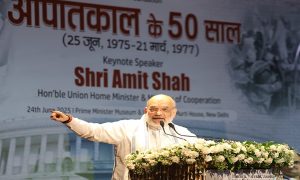Despite an increase in the number of seats after the implementation of the Economically Weaker Section (EWS) reservations, several Delhi University colleges have admitted more students than the number of available seats leading to an infrastructural crunch. Around 6,000 seats were added this year after the implementation of the first phase of EWS reservations, taking total number of seats to 62,000.
Several university officials HT spoke to said the phenomenon of “over-admissions”—admitting more number of students than available seats—has been taking place over the past few years, but this year, the increase is unprecedented.
“Over- admission has taken place in a few combinations of the BA programme. Our college is offering over 30 such combinations this year, which could attribute to the number of increase in admissions. We are trying to divide the students into different sections and are working on other such ideas to accommodate them,” said PK Shishodia, admissions convener for Zakir Hussain College, which saw 1,816 admissions for its 1,580 seats.
In Miranda House, at least 1,814 students were admitted, despite there being around 1,100 seats. “We opened a new academic block and have turned some board and seminar rooms into classrooms as well,” said acting principal Bijayalaxmi Nanda, adding that the college had also worked the timetable around to facilitate the increased number of students. The college, she said, also purchased extra microphones, furniture and other necessary equipment needed to accommodate more students.
“We have added an extra section for Political Science and have multiple sections for History as well. We have tried to limit sections with 80 students per teacher,” she added.
For 57 seats in the same course, Kirori Mal College has admitted over 250 students. Admissions convener Sunil Singh said the college has allotted the two biggest classrooms for the course, adding that the seating capacity of each room is 100. “There will be issues with equipment and space, but we’re trying to manage for now,” he said.
“Teachers have taken over and above their share of the workload with the increase in the number of students. While we may not face a lot of problems for a couple of years, we hope to receive adequate resources after the second tranche of OBC posts and EWS reservations is released,” Nanda said.
For its 827 seats, Hindu College saw over 1,130 admissions. “We kept the highest cut-off in Political Science (99%), yet we have double the number of students in the course,” said principal Anju Srivastava, adding that the college was working on ways to accommodate students. “Our entire planning goes haywire due to over-admissions. We have to look into different infrastructural requirements, such as washrooms, classrooms, human resources, and security arrangements, among other things.”
Principals across colleges have also attributed this increase in admissions to the lenient marking system of various boards, which has increased the number of top-scorers over the years. This year, 17,693 students scored 95% and higher in CBSE, which is 4,956 more than last year’s 12,737 students.
“All boards should standardise their marking system, otherwise the university may have to switch to entrance test-based admissions, which may give rise to coaching centres and guide books, pushing the underprivileged further out of the education system,” said the principal of a north campus college, requesting anonymity.
Many also speculated that the option of unchecking boxes this year, as opposed to selecting which subjects students wanted to choose while filling admission forms, may have had a role to play in the increase in over-admissions.
“Students barely unchecked any boxes, which meant that if they were eligible, they could take admission in any college in any of the listed subjects. Earlier, this wasn’t possible since they had applied for a select few courses from the beginning,” said a DU official, requesting anonymity.




























 WhatsApp us
WhatsApp us